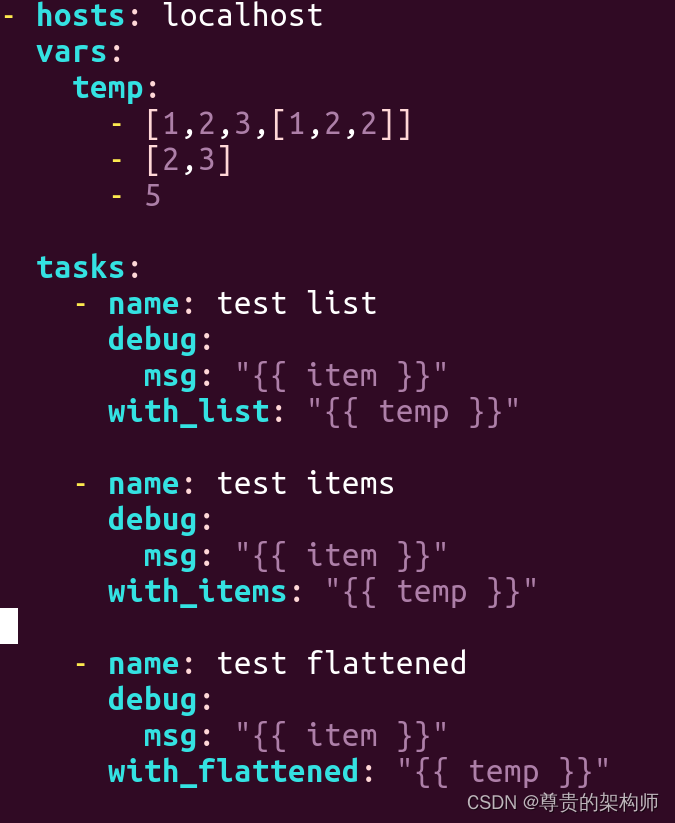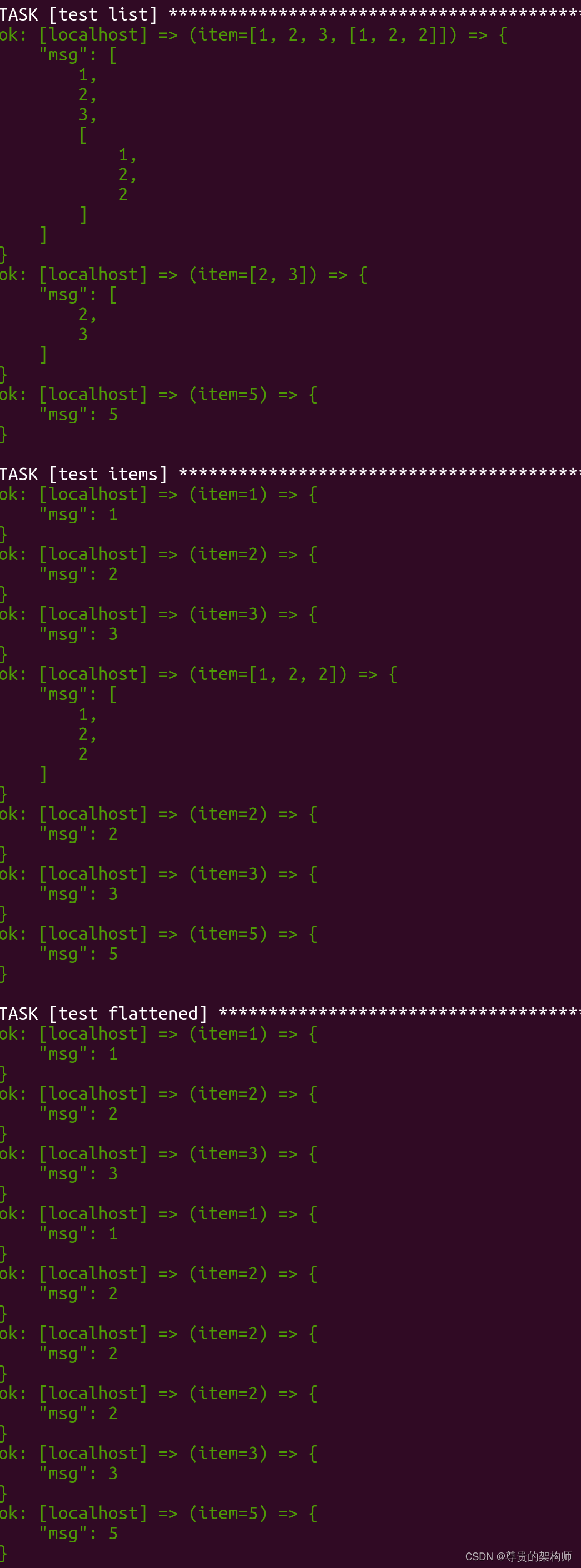一、【写在前面】
1. 废话
笔者最近在规划写几篇连续的文章,想来想去还是Ansible最值得记录:
一来是此工具学习曲线比较平缓,不会一看文档就不想学了,早期学习性价比非常高;
其次、这个东西基本都要用到,无论你是走什么方向,只要机器数量上来了,这个组件是大概率要接触到的,有一些厂会用其他的工具比如SaltStack或者Puppet但是理念差不多,先学ansible之后这些都很好搞懂。
最后、这个工具学习性价比很高,不需要太多的前置知识,短时间内就能拿起来用,当然这也意味着你在使用时要特别小心,因为一条命令可能就造成大量灾难。
笔者的文档本质是二手货,只是个人心得的一些记录,是官方文档的拙略模仿,如果恰好能帮到您,那就是意外的收获了。
前置知识:YAML(必需);shell、ini、jinja2(差不多会就行了)
PS: 官网所有的关键字都在这了,点个关注就能免费看,求支持
2. 简介
Ansible是一个批量管理机器的工具,通过一个或多个主控端控制被控机器。是用python开发的,主要用SSH通讯,其他协议为补充。支持主流Linux发行版本,甚至还支持管理windows(Ansible.Windows)和macos。其命名灵感来自于1966年小说罗坎农世界《Rocannon's World》,之后著名的电影《安德的游戏》中也致敬了此词——安塞波。在小说中,作者使用常用技能“加设定”,构造了一个虚拟概念安塞波,来解决主角远距离操控星舰打仗的延迟问题。

Ansible-Playbook也即ansible剧本是最常用到也是其最强大的功能,通过构建一个或多个剧本以及模板,来达到做出一系列复杂任务。因为主要用yaml来做剧本,所以基本有手就行,看看文档一天就能构建一个基本的多任务的剧本,再配合ansible-vault和ansible-pull(或者其他代码托管),很容易就可以构建起安全且高效的任务托管。
当然,正式开始之前,需要做好基本的软件安装和机器发现
二、【正式开始】
Ansible的关键字可以分为四类:PLAY, ROLE, BLOCK, TASK。正好对应了playbook的大致结构,简单来说,PLAY是一块内容包含一个或多个任务;ROLE可以理解为是一个类,这里被称为角色,通过不同角色来区分不同功能,也就是说ROLE中包含的内容会很多;BLOCK可以理解为也是多个任务的集合,但是包含了更多例如错误处理debug这样的功能;TASK则是ansible执行的最小单元,可以理解为语句,再小就执行不了了。
关键字可以直接理解为命令语句
(1). PLAY
1. any_errors_fatal
这个关键字表示,当任务执行中有任何错误发生,立马停止所有任务。
- name: Example of any_errors_fatal # 剧本的名字,这里开头有个' - '
hosts: all # 标注为一个PLAY, 可以理解为一个任务块
any_errors_fatal: true
tasks: # 真正的任务内容
- name: Fail the command
command: /bin/false2. become
这个关键字可以直接提权运行命令,become是一个布尔值,为真则用sudo提权,当然需要提前在对应机器配置好sudoer
- name: Example of become
hosts: all
become: true
tasks:
- name: Run a privileged command
command: systemctl restart nginx3. become_exe
针对become的补充,指定提权文件的文件夹
- name: Example of become_exe
hosts: all
become: true
become_exe: /usr/bin/sudo
tasks:
- name: Run a privileged command
command: systemctl restart nginx
4. become_flags
Ansible 2.5加入的关键词,默认是与在linux下的sudo参数一致,windows下参数则是logon_type 和 logon_flags。 linux默认是"-H -S -n"
- name: Example of become_flags
hosts: all
become: true
become_flags: '-E'
tasks:
- name: Run a privileged command with environment preservation
command: echo $MY_ENV_VAR
environment:
MY_ENV_VAR: "Example"
5. become_method
设置提权方法,比如设置为sudo或者su
- name: 使用 sudo 方法提权
hosts: all
become: true
become_method: sudo
tasks:
- name: 以 root 用户身份运行命令
command: whoami
6. become_user
提权后变成指定用户,但是远程用户要有权限切换才行
- name: 切换到特定用户
hosts: all
become: true
become_user: someuser
tasks:
- name: 以特定用户身份运行命令
command: whoami
7. check_mode
debug模式,设置为true后,只会检查而不会执行
- name: 检查模式示例
hosts: all
tasks:
- name: 尝试安装 vim
yum:
name: vim
state: present
check_mode: true
8. collections
collections是ansible一个比较强大的功能,可以理解为调包,在ansible强大的社区中,找到自己想要的功能。collection下面一般包含有ROLES, MODULES, PLUGINS, PLAYBOOKS,需要什么部分可以直接用.
比如下方片段,使用一个名为 my_namespace.my_collection 的 collection,其中包含一个名为 my_module 的模块和一个角色 my_role
---
- name: Example playbook using a collection
hosts: all
collections:
- my_namespace.my_collection
tasks:
- name: Use a module from the collection
my_module:
parameter1: value1
parameter2: value2
roles:
- my_role
9. connections
这个关键词,主要用于不同机器类型,设置不同的连接类型,比如ssh,winrm,社区还有SNMP,message bus等都可以用(这里笔者有一个疑问,用SNMP通信的一般是简单设备,用ansible一般是做什么)
- name: 使用 ssh 连接
hosts: all
connection: ssh
tasks:
- name: 执行远程命令
command: echo "Hello, SSH!"
10. debug
这个关键词是调试用的,这里设置为失败后开启debug
- name: 使用调试器
hosts: localhost
tasks:
- name: 尝试执行可能失败的命令
command: /bin/false
debugger: on_failed
11. diff
类似于linux的diff命令,显示文件差异
- name: 显示文件变更差异
hosts: localhost
tasks:
- name: 确保文本文件包含特定内容
lineinfile:
path: /tmp/testfile.txt
line: 'Ansible is awesome'
diff: yes
12. environment
设置环境变量
- name: 设置环境变量
hosts: localhost
tasks:
- name: 打印环境变量
command: echo $MY_VAR
environment:
MY_VAR: "Hello, Ansible!"
13. fact_path
Ansible 在执行 playbook 时通常会首先执行一个自动的信息收集步骤,称为 "Gathering Facts"。这一步骤收集的信息包括主机的网络配置、操作系统类型、硬件规格等,这些信息以变量的形式在后续的 playbook 中可供访问。当然用户也可以自定义fact,这里的fact_path就是保存这些内容的路径
当然另一个参数《gather_facts》不能为false,不过还好默认这个是true
- name: 自定义事实路径
hosts: localhost
fact_path: /custom/fact/path
tasks:
- name: 收集事实
setup:
14. gather_facts
ansible剧本运行前会获取机器的一些状态信息,这一步骤收集的信息包括主机的网络配置、操作系统类型、硬件规格等,这些信息以变量的形式在后续的 playbook 中可供访问。除了 Ansible 默认收集的事实外,用户可以通过编写自定义的事实脚本来生成额外的事实。这些脚本通常放在 /etc/ansible/facts.d 目录下(这是默认的 factpath),并需要返回 JSON 格式的数据。
- name: 不收集事实
hosts: localhost
gather_facts: false
tasks:
- name: 仅运行任务
debug:
msg: "Skipping fact gathering"
15. gather_subset
小时候经常听家长说,这个世界不是非黑即白的,当时虽然懂却很生气觉得很犬儒,但是现在长大了发现有的时候身不由己,真没辙。这个gatherfact也是这样,不一定就是收集或者不收集,可以只收集一部分机器信息
- name: 收集特定的事实子集
hosts: localhost
gather_subset: network,hardware
tasks:
- name: 显示收集的网络和硬件事实
debug:
var: ansible_facts
16. gather_timeout
设置获取机器信息的超时时间,这个如果不设置的话默认是10s,但我看有老外写这个后没有生效,有人说可以试试ANSIBLE_GATHER_TIMEOUT = "60"
- name: 设置事实收集的超时时间
hosts: localhost
gather_facts: true
gather_timeout: 30
tasks:
- name: 简单输出消息
debug:
msg: "Fact gathering with custom timeout"
17. force_handlers
这个就是执行失败的时候,的一个操作,可以用来做自救。配合handlers块使用
- name: 强制执行 handler
hosts: localhost
force_handlers: true
tasks:
- name: 失败的任务
command: /bin/false
notify: restart nginx
handlers:
- name: restart nginx
command: echo "Restarting Nginx"
18. hosts
非常有用,区分特定的主机组来执行任务,一般主机组是提前写到剧本里或者设置到ansible默认文件中。这里是指定webservers组来执行任务
- name: 针对特定主机组执行操作
hosts: webservers
tasks:
- name: 在所有 web 服务器上安装 nginx
yum:
name: nginx
state: latest
19. ignore_errors
字如其名,用来忽略错误
- name: 忽略错误
hosts: localhost
tasks:
- name: 尝试执行可能失败的命令
command: /bin/false
ignore_errors: true
20. ignore_unreachable
字如其名,忽略不可达的机器
- name: 忽略不可达的主机
hosts: all
ignore_unreachable: true
tasks:
- name: 尝试连接所有主机
ping:
21. max_fail_percentage
设置一个失败阈值,剧本在很多主机执行任务中,如果超出阈值就会终止剧本的运行
- name: 设置失败百分比阈值
hosts: all
max_fail_percentage: 30
tasks:
- name: 执行可能失败的任务
command: /bin/false
22. module_defualts
为模块设置一些默认值,比如默认安装的应用,默认拷贝的路径,但笔者认为,这个写多了,会让可读性变差
- name: 设置模块默认参数
hosts: localhost
module_defaults:
yum:
name: nginx
state: latest
tasks:
- name: 安装指定软件
yum:
23. name
见的比较多了,就是起个名字
- name: 提供剧本和任务名称
hosts: localhost
tasks:
- name: 输出消息
debug:
msg: "示例消息"
24. no_log
布尔值,控制是否输出日志,为真不输出。默认日志输出在/var/log/ansible,但是注意,ansible打印日志需要提前设置,看这个Logging Ansible output — Ansible Community Documentation
- name: 隐藏敏感信息
hosts: localhost
tasks:
- name: 显示敏感命令的输出
shell: echo "敏感数据"
no_log: true
25. order
排序,执行剧本的机器顺序,可以顺序执行,倒序执行,随机等,inventory(默认,按照模板的机器顺序执行)、sorted、reverse_sorted、reverse_inventory(按照模板的机器倒序执行) 和 shuffle(随机)
- name: 主机执行顺序
hosts: all
order: shuffle
tasks:
- name: 输出主机名
debug:
msg: "主机名是 {{ inventory_hostname }}"
26. port
设置连接到远端的默认端口
- name: 使用自定义端口连接
hosts: localhost
vars:
ansible_port: 2222
tasks:
- name: 检查本地端口
wait_for:
port: 2222
state: present
27. post_tasks
字如其名,后面的任务,也即在roles和普通task之后执行的任务
- name: 使用 post_tasks
hosts: localhost
tasks:
- name: 主要任务
debug:
msg: "执行主要任务"
post_tasks:
- name: 后置任务
debug:
msg: "执行后置任务"
28. pre_tasks
前面的任务,在 roles 执行之前先执行的任务列表
- name: 使用 pre_tasks
hosts: localhost
pre_tasks:
- name: 执行前置任务
debug:
msg: "在 roles 之前执行的任务"
roles:
- myrole
tasks:
- name: 主任务
debug:
msg: "主任务执行"
29. remote_user
指定远程登陆的用户
- name: 指定远程用户
hosts: all
remote_user: admin
tasks:
- name: 执行远程命令
command: whoami
30. roles
指定要导入到剧本中的角色列表
- name: 应用角色
hosts: localhost
roles:
- role: example_role
vars:
role_var: value
31. run_once
只跑一次的任务,只在第一个可以连接到的主机,进行任务
- name: 应用角色
hosts: localhost
roles:
- role: example_role
vars:
role_var: value
32. serial
控制并发数,可以是百分比10%,也可以是数字,代表着一次在这么多台机器执行,然后接着往下
- name: 使用 serial 控制批处理执行
hosts: all
serial: 2
tasks:
- name: 逐个主机执行
debug:
msg: "依次在两台主机上执行"
33. strategy
并发策略,常用的有linear、free、mitogen。
linear:
linear策略会按照主机列表的顺序依次在每台主机上执行任务。这意味着它会在一个主机上执行完所有任务,然后再切换到下一个主机执行任务,依此类推。- 这种策略适合于那些需要线性执行任务的场景,例如在主机之间有依赖关系,或者需要确保任务按照特定顺序执行的情况。
free:
free策略是 Ansible 2.10 版本引入的新策略。它允许任务在所有目标主机上自由并发执行,不受任何限制。- 这种策略适用于需要尽可能快速地执行任务,并且任务之间没有顺序要求的情况。在处理大量目标主机时,
free策略可以提高执行效率。
mitogen:
mitogen是一种优化策略,它通过在主机之间共享Python对象来提高执行效率。它能够显著减少任务执行的启动时间和网络开销。- 这种策略适用于大型环境和性能敏感的场景,可以加速任务的执行并减少系统负载。
- 请注意,使用
mitogen策略需要安装mitogen插件,并且可能需要对您的Ansible配置进行一些额外的调整。
- hosts: all
strategy: linear
tasks:
- name: Task 1
debug:
msg: "This is task 1"
- name: Task 2
debug:
msg: "This is task 2"
34. tags
很有用,可以在使用 ansible-playbook playbook.yaml --tags ‘thistag’ 的时候指定tag,这样就会只执行对应tag的任务
- name: 使用标签
hosts: all
tasks:
- name: 只有在特定标签被调用时执行的任务
debug:
msg: "这个任务包含一个特定标签"
tags:
- special
- name: 常规任务执行
debug:
msg: "这个任务总是执行"
35. tasks
任务块,在pre_tasks,roles之后执行,在post_tasks之前执行
- name: 执行主要任务
hosts: localhost
tasks:
- name: 打印信息
debug:
msg: "主任务列表中的任务"
- name: 检查磁盘空间
command: df -h
register: disk_space
- name: 显示磁盘空间信息
debug:
msg: "{{ disk_space.stdout }}"
36. throttle
设置并发数上限,有利于控制资源
- name: 使用限流控制并发执行
hosts: all
tasks:
- name: 并发限制任务执行
command: echo "Running task with throttle"
throttle: 2
37. timeout
超时设置,超时将认为失败
- name: 任务执行超时设置
hosts: localhost
tasks:
- name: 可能会长时间运行的任务
command: sleep 5
timeout: 2
38. vars
设置变量的,一旦设置,在当前层级生效
- name: 定义和使用变量
hosts: localhost
vars:
my_var: "Hello, Ansible"
tasks:
- name: 使用定义的变量
debug:
msg: "{{ my_var }}"
39. vars_files
大量的变量,可以用文件来定义,一般是yaml或者ini
- name: 从外部文件加载变量
hosts: localhost
vars_files:
- vars/extra_vars.yml
tasks:
- name: 使用外部定义的变量
debug:
msg: "{{ external_var }}"
(2). ROLE
除了play里面的关键词,还多了下面这些
1. when
就是if语句
- hosts: all
roles:
- role: configure-nginx
when: "'webserver' in group_names"
- hosts: all
roles:
- role: deploy-app
when: "ansible_os_family == 'RedHat' and ansible_distribution_major_version|int >= 7"
(3). BLOCK
除了上述的关键词,还多了下面这些
1. always
always 关键词在 Ansible 的错误处理和任务流控制中非常重要。它通常与 block 和 rescue 结构一起使用,确保无论前面的任务是否成功,都将执行指定的任务
- hosts: all
tasks:
- name: Attempt to execute a command
block:
- command: /bin/false
rescue:
- debug:
msg: "The command failed, handling error..."
always:
- debug:
msg: "This task runs no matter what happened before."
2. delegate_facts
delegate_facts 是在使用 delegate_to 时一起使用的选项,用于决定是否将从远程主机收集的事实带回到委托主机上。
- hosts: server1
tasks:
- name: Gather facts from another host
setup:
delegate_to: server2
delegate_facts: true
3. delegate_to
delegate_to 关键词用于将任务委托给另一台主机执行,而不是在当前目标主机上执行。
- hosts: webserver
tasks:
- name: Restart database server
service:
name: postgresql
state: restarted
delegate_to: dbserver
4. notify
notify 关键词用于触发 handlers 的执行。当一个任务发出 notify 调用时,它将触发在 handlers 部分定义的相应任务。
- hosts: all
tasks:
- name: Update the web server configuration
template:
src: /srv/httpd/templates/httpd.conf.j2
dest: /etc/httpd/conf/httpd.conf
notify:
- restart apache
handlers:
- name: restart apache
service:
name: httpd
state: restarted
# 在这个示例中,如果配置文件 httpd.conf 被更新,则会触发一个 handler 任务来重启 Apache 服务。
# 这些关键词扩展了 Ansible 的灵活性和控制力,使其能够更加精确地管理任务执行和应用逻辑。(4). TASK
除了上述的关键词,还多了下面这些
1. action
直接指定要运行的模块
- hosts: all
tasks:
- name: Shutdown remote machine
action: command /sbin/shutdown -t now
2. args
用来以字典形式明确地指定任务使用的参数。
- hosts: all
tasks:
- name: Create a directory
args:
chdir: /tmp
executable: /bin/mkdir
creates: test_directory
command: mkdir test_directory
3. async
用于设置任务的最大异步执行时间(秒),使任务在后台运行。因为考虑到有些任务可以丢到后台跑,顺序执行会卡后面任务的进度,所以这个时候用async可以让进度更快
- name: Run a long-running task asynchronously
shell: "some_long_running_task"
async: 300 # 超时时间300s
poll: 0
register: async_result
- name: Check the status of the async task
async_status: # 使用 async_status 模块来轮询异步任务的执行状态,直到任务完成
jid: "{{ async_result.ansible_job_id }}"
register: async_status_result
until: async_status_result.finished
retries: 60
delay: 104. changed_when
用于定义任务执行后是否更改的条件。每次跑ansible剧本,结束不是会有一个changed: 3 error: 1这种类似的信息吗
changed_when接受一个条件表达式,当表达式返回True时,任务将被标记为“已更改”,否则将被标记为“未更改”。
- hosts: all
tasks:
- name: Check if a file exists
command: ls /path/to/file
register: result
changed_when: "'No such file' in result.stderr"
5. delay
用在重试逻辑中,定义重试前的等待时间(秒)。
- hosts: all
tasks:
- name: Wait for web service to start
uri:
url: http://example.com
status_code: 200
register: result
until: result.status == 200
retries: 5
delay: 10
6. local_action
用于在控制节点上执行操作,等同于 delegate_to: localhost。
- hosts: all
tasks:
- name: Gather local facts
local_action: setup
7. loop
用来重复执行,并且配合item取数,第一次item是testuser1,第二次是testuser2
- hosts: all
tasks:
- name: Add several users
user:
name: "{{ item }}"
state: present
groups: "wheel"
loop:
- testuser1
- testuser2
8. loop_control
类似py的enumerate,index_var:用于指定循环的索引变量;loop_var:用于指定循环的循环变量。
- name: Loop example
hosts: localhost
tasks:
- name: Print loop index and item
debug:
msg: "Item {{ my_item }} at index {{ my_index }}"
loop:
- item1
- item2
- item3
loop_control:
label: "{{ item }}"
index_var: my_index
loop_var: my_item
9. poll
设置异步任务的轮询间隔,若为0则不轮询。这里设置了异步任务超时14400s,每10s轮询一次
- hosts: all
tasks:
- name: Run a background job
command: /usr/bin/some_long_job --option
async: 14400
poll: 10
10. register
用于捕获命令的输出
- hosts: all
tasks:
- command: echo "Hello"
register: echo_output
- debug:
msg: "The output was '{{ echo_output.stdout }}'"
11. retries和until
until定义任务应重复执行的条件,通常与 retries 和 delay 一起使用。
retries与 until 一起使用,定义重试次数。
- hosts: all
tasks:
- name: Check web service
uri:
url: http://example.com
return_content: yes
register: webpage
until: webpage.status == 200
retries: 5
delay: 2
12. with_<lookup_plugin>
也被称为with_X,是loop的一种,官方提供了很多with,有
- with_list(按列表循环),
- with_items(平铺一层并循环),
- with_indexed_items(索引管理),
- with_flattened(彻底平铺列表),
- with_together(取列),
- with_dict(迭代字典),
- with_sequence(生成一个数列并进行迭代),
- with_subelements(遍历一个列表的列表,要求有字典结构否则报错),
- with_nested/with_cartesian(笛卡尔积),
- with_random_choice(随机选取)。
可以看这个Loops — Ansible Community Documentation
光是with_X的内容就可以单独水一篇文章,这里先举一个简单例子
# 一个简单的三元素循环,指定列表进行迭代
- name: Print list items
debug:
msg: "{{ item }}"
with_list:
- one
- two
- three
有一点可以注意一下,with_list,with_items,with_flattened稍微有点区别,容易搞混。with_list是按列表频谱,也就是每个元素直接提取;with_items是会将列表的第一层拆开;with_flattened是彻底平铺,遍历每层,笔者写了个测试用例,可以看一下


三、【总结】
总结了一下ansible剧本的所有关键字,官网文档的关键字就这么多,基本看明白了关键字搞懂了剧本结构,就可以开始写剧本了。
四、【参考】
2. Playbook Keywords — Ansible Community Documentation